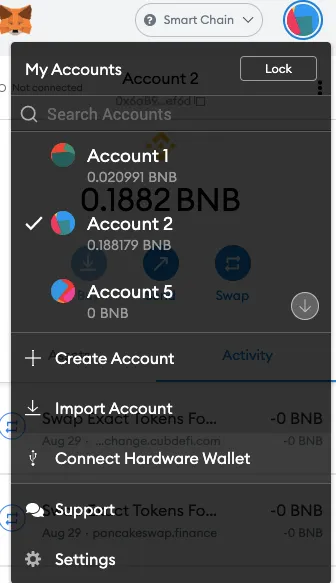I recently connected my Trezor hardware wallet to my MetaMask account, well, two accounts to be precise.
I did this because of the additional security this provides compared to just having my funds stored in MetaMask.
Now my keys are stored in the Trezor hardware wallet rather than on MetaMask and I have to have the Trezor physically connected to my computer via Trezor Suite and confirm any transactions that involve moving funds around (sending/ withdrawing from or staking to pools) by clicking 'agree' on the Trezor itself.
I have a cheaper Trezor one (Rather than the more expensive T model) and it was very easy to connect..
Connecting Trezor to MetaMask...
The process is outlined in this post from Binance, or if you want an alternative this post from Coinstop will take you through the same stages, non Binance.
The process goes something like this:
- Make sure you've got your Trezor back up phrase safe and secure just in case.
- Update the Trezor firmware if you need to.
- Connect Trezor to Trezor Suite
- Open up MetaMask and click 'connect hardware wallet'
- Then just follow the instructions from within the Trezor dashboard.

It's all outlined in sufficient detail in those posts linked above.
It took me a while to get my head around how this all works - when you connect your wallet and 'link' it with Trezor it actually creates a brand new ETH address for you, with the Keys stored on the Trezor, not MetaMask.
Once you've created your new 'Trezor secured browser wallet', you will then have to manually transfer any funds over from your 'old wallet' to your new 'Trezor secured wallet', which is easily done from within Metamask - and if you're going from an old account to a protected one, there's no 'agreeing via Trezor' required.
NB I was doing this mainly to secure funds on Binance Smart Chain, where the fees are relatively low.
This was just as well because with a brand new wallet this means you have to 'approve' every new pool you want to interact with and then I had about 10 different pools to come out of and more liquid assets to transfer over, so the whole thing cost me 10* unstaking/ transferring/ restaking, so 30 Txs over all.
You'll probably want to 'add the token-assets' using the token address on BSC (if you're on BSC!) to the new wallet before you send, so you can actually see them when they arrive!
You don't have to unpool funds, you can just send to the 'LP' tokens across, and if you've already 'approved' the pool on the new wallet, that also adds the LP to metamask, so you can see those funds when they arrive (no need to add the LP contract address manually like you have to in order to be able to 'see' freshly sent liquid tokens.
Security Advantages....
Now my keys are stored in the Trezor hardware wallet rather than on MetaMask and I have to have the Trezor connected via Trezor Suite and confirm any transactions that involve moving funds around (sending/ withdrawing from or staking to pools) by clicking 'agree' on the Trezor itself.
I can still see what funds I have in my MetaMask/ Trezor Wallet without the Trezor being connected, but to DO anything with those funds I need the Hardware Wallet connected to sign transactions.
Presumably this means that if someone gets hold of my MetaMask seed phrase - which feels week, it's only a piddly 12 words, they will be able to see my funds in their 'imported account' but they won't be able to move them anywhere!
(I actually quite like the idea of this - can you imagine the frustration!)
I believe security also works the other way... if someone gets hold of my Trezor seed phrase, my funds are on MetaMask, so they can't access them that way either.
I think?!?
Downsides
It is more inconvenient, I need to have my Trezor in order to be able to do anything on MetaMask, BUT, that's not a bad thing as it makes me use it less, which saves me fees.
And if I get desperate to move around small funds, I can always use one of my non-Trezored accounts.
I haven't used this with any of my ETH funds on Metmask, that's my next shift-over, the FEES are going to be the usual ETH fees, but I think it'll be worth it for the value of funds I've got there.
The only real downside security wise is that I'm now more dependent on my Trezor than ever - that back up phrase is now more vital than ever!
Final Thoughts
I'm MUCH happier now most of my MM funds are Trezor-wrapped, I think I might buy a Trezor Three pack and look to split my funds across multiple devices, and keep one spare if I lose one or one malfunctions!
